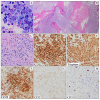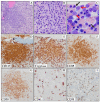Review and Updates on Systemic Mastocytosis and Related Entities
- PMID: 38067330
- PMCID: PMC10705510
- DOI: 10.3390/cancers15235626
Review and Updates on Systemic Mastocytosis and Related Entities
Abstract
Mast cell disorders range from benign proliferations to systemic diseases that cause anaphylaxis and other diverse symptoms to mast cell neoplasms with varied clinical outcomes. Mastocytosis is the pathologic process of the accumulation of abnormal mast cells in different organs, mostly driven by KIT mutations, and can present as cutaneous mastocytosis, systemic mastocytosis (SM), and mast cell sarcoma. The WHO 5th edition classification divides systemic mastocytosis into bone marrow mastocytosis, indolent systemic mastocytosis, smoldering systemic mastocytosis, aggressive systemic mastocytosis, systemic mastocytosis with an associated hematologic neoplasm, and mast cell leukemia. The new ICC classifies SM slightly differently. The diagnosis of SM requires the integration of bone marrow morphologic, immunophenotypic, and molecular findings, as well as clinical signs and symptoms. Moreover, understanding the wide range of clinical presentations for patients with mast cell disorders is necessary for accurate and timely diagnosis. This review provides an updated overview of mast cell disorders, with a special emphasis on SM, including the latest approaches to diagnosis, prognostic stratification, and management of this rare disease.
Keywords: KIT; WHO 5th Edition Classification of Haematolymphoid Tumours (WHO 5th edition); classification; diagnosis; hereditary alpha-tryptasemia (HαT or HAT); mast cell activation syndrome (MCAS); molecular; systemic mastocytosis (SM); the International Consensus Classification (2022 ICC); treatment.
Conflict of interest statement
All the authors have no conflicts of interest to declare.
Figures




Similar articles
-
Mastocytosis and related entities: a practical roadmap.Acta Clin Belg. 2023 Aug;78(4):325-335. doi: 10.1080/17843286.2022.2137631. Epub 2022 Oct 19. Acta Clin Belg. 2023. PMID: 36259506 Review.
-
The international consensus classification of mastocytosis and related entities.Virchows Arch. 2023 Jan;482(1):99-112. doi: 10.1007/s00428-022-03423-3. Epub 2022 Oct 10. Virchows Arch. 2023. PMID: 36214901 Review.
-
Diagnostic criteria and classification of mastocytosis: a consensus proposal.Leuk Res. 2001 Jul;25(7):603-25. doi: 10.1016/s0145-2126(01)00038-8. Leuk Res. 2001. PMID: 11377686 Review.
-
Clinical Impact of Inherited and Acquired Genetic Variants in Mastocytosis.Int J Mol Sci. 2021 Jan 2;22(1):411. doi: 10.3390/ijms22010411. Int J Mol Sci. 2021. PMID: 33401724 Free PMC article. Review.
-
Systemic Mastocytosis and Other Entities Involving Mast Cells: A Practical Review and Update.Cancers (Basel). 2022 Jul 17;14(14):3474. doi: 10.3390/cancers14143474. Cancers (Basel). 2022. PMID: 35884535 Free PMC article. Review.
Cited by
-
Indolent Mastocytosis and Bone Health: Molecular Mechanisms and Emerging Treatment Options.Int J Mol Sci. 2025 Jun 12;26(12):5649. doi: 10.3390/ijms26125649. Int J Mol Sci. 2025. PMID: 40565113 Free PMC article. Review.
-
Defining "Normal" basal serum tryptase levels: a context-dependent approach to improve diagnostics in systemic mastocytosis.Front Allergy. 2025 May 12;6:1592001. doi: 10.3389/falgy.2025.1592001. eCollection 2025. Front Allergy. 2025. PMID: 40421126 Free PMC article. Review.
-
Fatal anaphylactic shock due to hymenoptera venom in a farmer suffering from indolent systemic mastocytosis. The comparative diagnostic relevance of perimortem serum tryptase levels.Int J Legal Med. 2025 Jul;139(4):1903-1911. doi: 10.1007/s00414-025-03487-1. Epub 2025 Apr 2. Int J Legal Med. 2025. PMID: 40172633 Free PMC article.
-
Nanoparticles may influence mast cells gene expression profiles without affecting their degranulation function.Nanomedicine. 2025 Jun;66:102818. doi: 10.1016/j.nano.2025.102818. Epub 2025 Apr 2. Nanomedicine. 2025. PMID: 40185352
References
-
- Valent P., Akin C., Nedoszytko B., Bonadonna P., Hartmann K., Niedoszytko M., Brockow K., Siebenhaar F., Triggiani M., Arock M., et al. Diagnosis, Classification and Management of Mast Cell Activation Syndromes (MCAS) in the Era of Personalized Medicine. Int. J. Mol. Sci. 2020;21:9030. doi: 10.3390/ijms21239030. - DOI - PMC - PubMed
-
- Valent P., Akin C., Hartmann K., Nilsson G., Reiter A., Hermine O., Sotlar K., Sperr W.R., Escribano L., George T.I., et al. Advances in the Classification and Treatment of Mastocytosis: Current Status and Outlook toward the Future. Cancer Res. 2017;77:1261–1270. doi: 10.1158/0008-5472.CAN-16-2234. - DOI - PMC - PubMed
Publication types
LinkOut - more resources
Full Text Sources
Molecular Biology Databases

